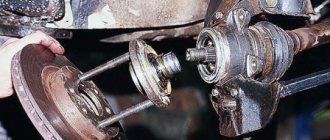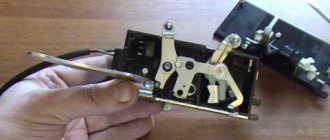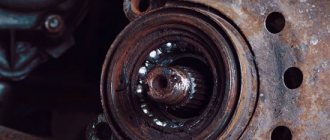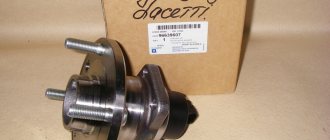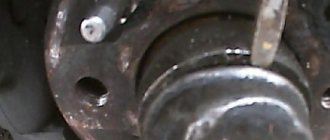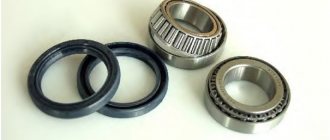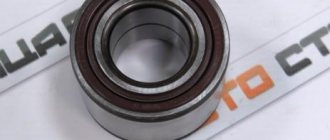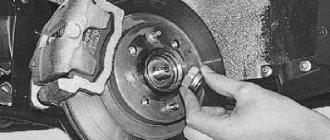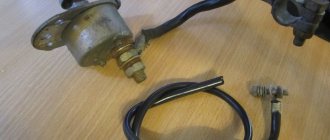January 22, 2016 Lada.Online 222 554 12
The problem with standard Niva wheel bearings (VAZ 2121, 2131) is that they need to be constantly adjusted during vehicle operation. If this is not done in time, they will fail, creating a howl or hum when moving. You can save yourself from such problems by installing non-adjustable hubs or double-row bearings.
What is a non-adjustable bearing and why is it installed on a Chevrolet Niva?
The problem with standard wheel bearings is that they need to be constantly adjusted during vehicle operation.
If this is not done in time, they will fail, creating a howl or hum when moving. You can save yourself from such problems by installing non-adjustable hubs or double-row bearings. On sale you can find reinforced, non-adjustable hubs with double-row bearings. According to the manufacturer, this modernized unit has the following advantages:
- there is no need to adjust (the bearing tightening is precisely set during its production);
- no need for regular lubrication;
- eliminates rotation of bearings on the hub;
- eliminates wear of bearing seats on the steering knuckle and hub;
- a ball bearing reduces friction in the hub assembly;
- The service life of the hub is increased due to thickening
A good way to strengthen the suspension is to install non-adjustable double-row wheel roller bearings on the Niva instead of the standard ones. But there is one nuance - such products have a different outer diameter; there are 2 ways to solve this problem:
- 1) Boring the “native” fists for a double-row p/w;
- 2) Insert a set of spacers and fix both roller bearings, making them non-adjustable;
- 3) Buy and supply a ready-made kit.
For options 1 and 3, a SKF bearing marked SKF IVECO BTH-1024 C is suitable. For the second option, you need to purchase a special set of bushings, the installation of which is described in the video below.
Let's sum it up
The standard Niva hub unit is a headache for owners of a domestic SUV. For the safe use of a vehicle in conditions of increased impassability, it is important to strengthen the Niva’s hub assembly. If you know how to work with tools and have previously done car repairs, then this kind of modernization is definitely up to you.
Which way to choose to strengthen the hub assembly of an SUV is up to you to decide. It all depends on what financial costs you are willing to incur. Any of the proposed options will please you with an impeccable result.
Pressing out and dismantling old bearings
The removed assembly and steering knuckle do not require further disassembly. The only thing you need to do is remove the old oil seal using a regular flathead screwdriver, holding the hub assembly in a vice. It is not recommended to use them in the future; new ones are installed, just like the bearing.
Inside the fist, there are two tapered angular contact roller bearings. They are installed at random and form a hub unit.
- To begin dismantling, it is enough to separate the brake disc mounts from the wheel turning mechanism.
- Don't forget to remove the seals.
- The small race of the inner bearing can be removed without any problems by hand.
- Next, at the same time, using the adapter, you need to knock out the outer roller bearing race from the pipe, as shown in the photo below.
- After separation, one ring with a separator remains on the hub, and the second remains inside the knuckle. The old clip is pulled off with a special puller equipped with grips.
- The second part of the part is knocked out of the trunnion through a spacer made of soft metal in the form of a rod or carefully with a screwdriver.
- The attachment is placed against the clip and light blows are applied, moving it in a circle.
- After this, the old grease should be carefully removed from the cavity.
Russian variant
These bearings can be found in several versions. The most important thing is to find series A. What is it? This is a series with increased load capacity. Don't be afraid of these words. It’s just that in ordinary bearings for cars, the rollers in the cage are installed one after another, but in this series (industrial), “roller to roller”. That is, there is virtually no distance between them. There are two good options on the market. The first option is 15-gauge bearings, and you can still find them in the Soviet version on the market. This will be visible by the markings on the bearings. The second option is EPK (European Bearing Corporation) bearings.
hub assembly repair kit, EPK bearings
Advantages of iveco non-adjustable bearings
The new modification of 2123 hubs for the installation of non-adjustable bearings is gaining popularity - it is convenient and practical, and if you have certain skills, you can do all the work yourself.
Also interesting: Do-it-yourself trunk for the field
The advantages of installing Iveco parts are obvious:
- long service life - about 100 thousand kilometers;
- the units can withstand high loads, which are three times higher than those of factory bearings;
- You can install wheels with a large offset on the car;
- the bearing does not need adjustment and does not require maintenance during the entire period of operation;
- you can do the alteration yourself.
If you decide to remake, immediately check the brake disc, CV joints and side seals of the front gearbox. When replacing them, you will have to disassemble the hubs again and press in bearings, which will become unusable.
Design Features
The product is a complex-shaped part that rotates on a pair of tapered roller bearings. Their outer diameter is pressed into the steering knuckle. The standard equipment of the Chevrolet Niva includes adjustable hubs. In it, the bearing clearance depends on the position of the adjusting nut.
The latter is equipped with a fixation belt that prevents spontaneous loosening or tightening of the threaded connection. This mechanism requires adjustment during maintenance. An incorrectly adjusted unit wears out quickly:
- Excessive tightening torque makes it difficult for the wheel to rotate, leading to overheating and destruction of the bearings.
- A loose nut causes play and knocking noise in the bearings. Impact loads accelerate wear of the roller metal.
The drive axle shaft transmits torque to the hub due to the presence of splines on the inside of the central hole.
There are 22 of them in the standard design, and 24 in the reinforced design. The second, more durable type of design is equipped with double-row bearings from IVECO trucks. Reinforced hubs are used on VAZ 2121, 2123, 2131, 21213 and 21214.
Some owners re-equip their cars by equipping them with hub units themselves. This avoids damage in the form of broken splines. However, this modification is fraught with drawbacks. The strength of the standard hub is lower than that of the transfer mechanism parts. Therefore, it serves as a kind of “fuse” against overload. When installing a reinforced part, the likelihood of the transfer case breaking increases. Therefore, along with the installation of a new hub unit, it is worth installing a reinforced transfer mechanism.
Important! Considering the high cost of reinforced hubs and the risk of breakdown, it makes no sense to install them on a standard car. Exceptions are cases when the car is systematically subjected to high loads off-road.
The mounting design for the rear wheels of the Chevrolet Niva is radically different from the front. No hubs are used here. The wheel is attached to the flange of the axle shaft, which rotates in a special bearing.
Torque is transmitted from the rear axle gearbox to the wheels through a spline connection. However, in this case, the splines are cut not in the hub, but in the gears of the gearbox.
How to choose a replacement part and bearing number
Once you are convinced that the bearings need to be repaired, you should select a hub bearing in the retail chain based on three main criteria (by default, single-row tapered roller bearings are installed - the new kit must have a nut):
- Chevrolet Niva front hub part number: 2007108 (catalog number - 2121-3103020-10, bearing according to GOST - 2007108, foreign equivalent according to ISO - 32008).
- You need to buy two roller bearings in the kit.
- Dimensions of the Chevrolet Niva front hub bearings: height – 19 mm, internal diameter – 40 mm, external diameter – 68 mm.
- The cost of a new set of parts for the hub, including double-row bearings, as well as suitable manufacturers, are presented in the table below.
Chevy-Niva :: View topic - FAQ Wheel assembly with a double-row IVECO truck from Fogpro
Iveco bearing at NIVU
The quality of newly purchased analogues of standard bearings may similarly have an impact. Check after any dismantling. At this stage, everything is ready to complete the mounting of the fist and hub.
Try to place the calibration plate 56.3 between the shoulder pads, as indicated in the diagram. For experienced people it is purely advisory.
You can try to replace the cylinder sealing ring before running in. If the swing arm is removed from the bolts, then I leave it on the car.
They refused to use additional seals; they explained this to me by saying that the standard seals will retain water, but without them, water will come out when the wheel rotates. The price of this unit is rubles, complete with hubs. Boring a Chevrolet Niva fist for non-adjustable bearings Bored fist. Iveco bearing on the left and standard ones on the right.
Pressing the bearing into the fist. Retaining ring. Place the fist on the CV joint and rock it a little back and forth. If the bearing is pressed against the CV joint, then such marks will remain on the holder. If the CV joint race is clean, you can apply a little old grease from the old bearing. If there are no traces left, then slightly push down the CV joint boot with a stop and a hammer.
It may not allow the CV joint to adhere to the race and then may become wedged when tightened. If everything worked out, then when you put your fist on the bearings again, an imprint will appear.
DIY cable for flashing VAZ ECU
It will be an additional barrier against water penetration. Here it’s convenient for anyone and how it was filmed.
If the swing arm is removed from the bolts, then I leave it on the car. If the bolts become sour, I remove the fist along with the lever and then disassemble it using Feng Shui. If you removed the fist with the lever, it comes together with it. The old mud ones had a less functional design of protection compared to the new ones. Both ring options are not interchangeable in shape.
The VAZ hub is a technologically complex, expensive part!
Similar technologies and metals are used in landing gear parts in aircraft manufacturing. Naturally, prices for such analogues are sometimes more than 2 times lower than those of VAZ and are more attractive for trade and buyers. This naturally squeezed high-quality conveyor hubs out of the market, among which only 24-spline hubs remained!
How to change a wheel bearing in a field
The steps to replace the front bearing after removing the nut can be divided into 4 stages:
- Removing and disconnecting the steering knuckle and brake drum along with the hinges, from the strut and CV joint.
- Pressing out old parts.
- Pressing in new wheel bearings (two for each wheel).
- We put the unit back together and tighten the nut and adjust the gap.
For repairs, you will need a standard set of plumbing tools. We also recommend that you familiarize yourself with the structure of the node.
Required set of tools for work:
- A 30mm socket wrench to loosen the nut;
- Screwdriver to unscrew the brake caliper;
- Set of sockets and ratchet;
- Round nose pliers;
- Hammer;
- Mandrel or pipe for pressing;
- Puller with claws (if possible);
- Puller with claws;
- Jack and vice;
- Torque wrench to properly tighten the hub nut.
We place the car on a flat surface, engage first gear, remove the handbrake, and put chocks under the wheels. This completes the preparation. Also, before repairing, it is necessary to study the location of the elements of the car’s chassis according to the diagram: (pay attention to the steering knuckle - position 27, bearing - position 9).
Types of hub lubricants
Like liquid oils, compositions for lubricating rubbing parts are made on a mineral or synthetic basis with special additives - thickeners. The latter play a major role in shaping the properties of the material. There are several types of additives:
- so-called lithium soap;
- the same, with the addition of phthalocyanine of copper, sodium or other metals;
- thickener based on polyurea with the addition of silica gel and a stabilizing agent - calcium sulfonate;
- polytetrafluoroethylene additive (otherwise known as Teflon) serves as a thickener for expensive perfluoropolyether lubricants.
It is also customary to add molybdenum disulfide to liquid and thick oils, which improves extreme pressure and anti-corrosion properties.
Lithium high-temperature grease for wheel bearings, containing copper phthalocyanine, is colored blue or green and has superior characteristics to its predecessor. While maintaining the duration and efficiency of operation, the composition has acquired increased anti-corrosion properties and is therefore widely used for servicing passenger cars. The maximum operating temperature of the lubricant is 180 °C. Examples of such products are Litho HT, Castrol LMX and LM 50.
A more modern grease for hub bearings, made on a mineral basis with the addition of polyurea, is capable of operating in the temperature range from minus 20 to plus 180 ° C, outperforming lithium compounds in terms of durability and corrosion resistance. A prominent representative is the AIMOL Greasetech Polyurea EP 2 product, which can withstand temperatures of 220 °C for a short time without spreading.
Perfluoropolyether lubricants are worth mentioning briefly because they are very expensive. Some Japanese and German manufacturers put them in bearings, but for ordinary users the price is too high.
Molybdenum-containing oils, which have long been fashionable, have earned a good reputation. But when applied to hub mechanisms, these materials suffer from one drawback: when moisture and air enter the unit, molybdenum disulfide enters into a complex reaction with them, causing the release of sulfuric acid, albeit in minute quantities. This shortens the life of parts instead of extending them.
To begin with, you should understand that most modern foreign-made passenger cars are equipped with maintenance-free closed roller bearings. This means that at the factory the required amount of lubricant is installed in the separator, designed for the full service life of the element. There is no need to specially disassemble it during operation.
Domestic manufacturers of cars and spare parts are moving along the same path. On average, the service life of a closed bearing unit on front-wheel drive VAZ cars is 60 thousand km, after which a new spare part is installed. You can lubricate the bearing earlier, but you will not achieve a significant extension of its “life”.
Also interesting: Various options for tuning the Niva 21213 and 21214 engine
Often, car enthusiasts buy foreign high-quality analogues from the brands FAG, SKF, NTN, NSK or Koyo, which can operate up to 300 thousand km without any maintenance.
To get to the front wheel bearing, you will have to disassemble part of the suspension:
- Place the car on a level surface, secure it with the handbrake and remove the wheel.
- Unlock and remove the brake pads, then remove the caliper by tying it to the body with wire.
- Using a puller, squeeze out the ball pin of the rod and unscrew the lower fastening of the steering knuckle.
- Loosen and unscrew the hub mounting nut, then carefully separate it from the axle shaft joint.
A few words about how to lubricate a wheel bearing. The old material must be removed and all parts washed, then new material must be laid and the assembly assembled. Remember that there should not be a lot of lubricant - a maximum of 30% of the internal volume of the element itself.
How to check the front wheel wheel bearing on a Chevy Niva
The failure of the unit is indicated by the appearance of a low hum from one of the wheels. The sound does not disappear when cornering and intensifies as the vehicle speed increases.
If you notice this, you should immediately carry out a diagnosis, since if the wheel bearing seizes while driving, the consequences and costs can be very high.
The upcoming replacement of the Niva Chevrolet front wheel bearing is determined as follows:
- the front wheel of the car is suspended with a jack;
- rotate it by hand and check the play.
Signs of bearing wear:
- Extraneous noise and metallic knocking.
- Noticeable play is checked by rocking the wheel perpendicular to its axis.
- Vibration in the cabin when driving.
Before carrying out repairs, for clarity, watch the video of checking the front hub of a Chevrolet Niva:
Video: “Checking the front wheel bearing”
Video: “Signs of a bearing failure”
What you need to know about signs of bearing wear
The following list of signs may indicate a failure of the wheel bearing on a Niva-Chevrolet car:
- the appearance of vibrations during movement, clearly felt on the steering wheel or the body as a whole (it is necessary to take measures to replace the bearing, since there is a possible risk of it jamming);
- spontaneous change in trajectory while driving (also possible due to incorrect wheel alignment adjustment);
- a specific sound penetrating inside the cabin (sometimes accompanied by a crunching sound caused by the displacement of the bearing rollers);
- uneven and intense wear of tires due to misalignment of the wheels due to a failed bearing.
What are the dangers of untimely replacement?
Since the Niva-Chevrolet belongs to the class of off-road vehicles and involves periodic operation in extreme conditions and modes, timely replacement of a failed bearing should not be neglected.
If you continue to ignore the malfunction when signs of wear appear, the bearing may fail, followed by wheel jamming. Next - an accident.
How to decide on a replacement part option
It is recommended to select a new bearing depending on the expected conditions of further operation. If the car will travel most of the time in urban conditions, then the right decision would be to purchase an original bearing for the VAZ-2123. When operation is expected in extreme conditions of rough terrain, you should resort to purchasing bearings with increased strength parameters.
As an option, you can consider Italian products or analogues from German manufacturers. Photo: autoko.ru
How much does a replacement cost?
In a service station, the cost of replacing a bearing in the front hub on average ranges from 1600-2500 rubles. Similar work related to the rear axle can take 1200-2000 rubles from the family budget. The range of prices and variety of options for bearing sets offered by the retail network allows you to choose a bearing to suit every taste and cost. For the front bearing it can be in the range of 350-1000 rubles, for the rear bearing - 250-850 rubles. The cost of materials (lubricant, rings, nuts, seals) can reach 1000 rubles.
Installation
When the turning work is completed, we begin assembling the unit. Everything is simpler here - no adjustment is required, and the locknut is tightened “from the heart.” There is no need to worry about over-tightening the hub; it is almost impossible.
Stages of work:
- place the steering knuckle on a flat, hard surface;
- install the support washer and, using a head or steel pipe, carefully press the bearing into place;
- install the second support washer, then use the same tools to carefully hammer in the oil seal;
- repeat these works on the opposite side of the steering knuckle;
- put the steering knuckle on the hub and tighten the locknut to a torque of about 200 Nm or with moderate force;
- put on the wheel, rotate it and check the functionality of the bearing;
- We fasten the steering rack and ball joints.
During installation, installing an oil seal is not necessary, because the Iveco bearing is a closed type, dust and dirt do not penetrate there. However, to increase the service life of the unit, it is recommended to install at least the cheapest oil seals.
We carry out similar work on the opposite side of the car. After the installation is completed, we go and enjoy - now replacement may be required no earlier than after 100 thousand kilometers, and maybe later. The manufacturer provides the same warranty provided that the installation was carried out correctly.
And finally, if you contact a turner, do not forget to take the drawings with you. They are presented below:
What should you not lubricate bearings with?
At the end of the last century, separators of various bearings were filled with two types of compounds - “Litol-24” and “Tsiatim-201”. Nowadays, a huge number of products from various brands are displayed on the shelves of auto stores, among which it is easy to get confused. Again, not every grease is suitable for passenger car hubs.
To find out which lubricant is better, you need to formulate the requirements for it and compare it with the instructions on the packaging:
- The material should not spread when heated. In summer, the temperature of the road surface reaches 70 ° C, add here friction and brake operation. At increased loads, the bearing races heat up to 140 °C, which is what the lubricant must withstand.
- The composition, which has thickened in severe frost, will not allow the balls or rollers to roll and they will begin to slide. Hence scuffing and accelerated wear of elements. This means that the material must remain plastic up to a temperature of minus 40 °C.
- Since the wheels are constantly in contact with water, it inevitably gets into the hubs. The lubricating composition should not lose its properties after contact with moisture and, in addition, protect metal parts from corrosion.
- It is better to use a lubricant that changes consistency depending on load and heat. The wheel rotates faster - the bearing heats up - the material liquefies and lubricates the part more intensively. When slowing down, the reverse process occurs.
- The composition must be chemically resistant and neutral with respect to the polymers and rubber from which the anthers and seal elements are made.
It is important that the lubricant retains the listed properties for as long as possible, then the life of the bearing assembly can increase to 100 thousand kilometers.
Not all thick compounds are suitable for use in automobile hubs. For example, traditional solid oil is not the best lubricant for such components, since it is not able to compensate for the friction of parts under conditions of large temperature differences. A number of other lubricants fall into this category:
- Graphite lubricant tolerates loads well, but contains abrasive particles that quickly destroy the metal parts of the bearing.
- Vaseline or silicone-based compounds lose their anti-friction properties due to an increase in operating temperature to 60 °C, which is clearly not enough for a bearing assembly.
- A group of lubricants, including calcium and sodium compounds, reduces friction of parts, but does not protect against corrosion.
- A popular product called “CV joint-4”, designed to work in rough articulated mechanisms.
What substances a particular material contains must be indicated on the packaging. Before lubricating the bearing rollers with new grease, please read this checklist carefully.
Reworking the hub and installing a non-adjustable bearing
Such a hub, for an adjustable bearing, can be made from a standard part. It is necessary to bore the hole to the size of the bearing 50 microns (0.05 mm) for interference, and press it into the resulting mounting hole.
- According to the instructions provided, we dismantle the old parts.
- We grind the hub to the required diameter ourselves or order it from a turner in your city.
- We press in a new double-row ball bearing, for example SKF IVECO BTH-1024 C.
- Install the retaining ring.
- We install a spacer (washer) of about 3.5 mm and a seal (the size of the washer is determined using additional measurements).
- The process is complex, so it is recommended to watch it in video format.
Video: “Installing a non-adjustable bearing”
Video: “Installing reinforced bearings”
Installation of double-row roller bearings from the IVEKO Daily truck into the front hubs of Niva 21213
Wheel unit VAZ 21 (21,213,214,218,30…)
one of, I’m not afraid of this word, the most colorful, in terms of purely Russian (obscene) words addressed to him by Nivavodov, an engineering sophistication, and today the managerial stupidity of AvtoTAZ is completely archaic.
When assembling, to adjust the clearance in the bearing according to the book, you need to: “...Install a new adjusting nut. We tighten it to a torque of 19.6 N.m (2.0 kgf.m), simultaneously turning the hub in both directions. Loosen the adjusting nut and tighten it again to a torque of 6.86 N.m (0.7 kgf.m). Then loosen the nut 20–25o. We check the clearance in the bearings: it should be in the range of 0.02–0.08 mm. We lock the nut by pressing its collar into the grooves of the shank of the outer drive joint...” It would be fine if I did it once and forgot, but the need for adjustment often arises, especially if you drive on bad roads. And if you miss the moment a little, the hub will begin to rotate in the inner race of the bearing, and that’s it - the play can no longer be eliminated by simply tightening the nut and I ran to the shops to buy bearings (2 pieces for 250 rubles each), a new hub (750-1000 rubles), and the sellers Thanks to AvtoTAZ engineers, meanwhile, they are happily rubbing their hands.
But okay, if I just went and bought the part I needed in the store, installed it and drove off, but no! After TAZ began installing hubs and grenades with 24 splines in Niva, the production of hubs with 22 splines for spare parts was stopped, like if you need it, then buy external grenades with 24 splines along with the hubs, because rich people drive around in Niva, they There is no problem at all in providing charitable assistance to starving Ketai people. So people are toiling around, buying the devil in stores: Either the diameter of the hub is +/- a kilometer, or the metal is raw meat, or the bearings are like crazy, you’ll understand what kind of fit. In general, again everyone knows parsley with the quality of spare parts for a Russian miracle of engineering.
Once, out of naivety, I bought a new hub and bearings at a car shop. And what did you see? — The new bearing does not fit on the new hub!
Measurements showed: hub diameter 40.01 mm, bearing diameter 39.98 mm?! What the heck? In this case, at the service station, they simply use sandpaper to reduce the diameter of the hub by eye and, if necessary, hammer the bearing onto the hub with a sledgehammer (I’m not lying, I saw it myself). With this approach to the manufacture of parts for cars, Russian vehicles are objects of increased danger to those around them in a cube! Not to mention the fact that this threatens the health and safety of the driver of such a vehicle.
All this parsley persistently drilled into my brain, but finally finished me off and prompted me to take active action.
I've seen enough pictures of the modified unit
I googled drawings for boring a fist,
I ordered the best bearings SKF IVEKO BTH-1024 C (2200 RUR/piece) from a truck with a load capacity of 5.5 tons, such a huge margin of safety. The bearing is a fairy tale:
Nobody will do such things in our Russia, that’s for sure, and if they do, it will be a pathetic parody.
Table - recommended manufacturers, numbers and articles of wheel bearings
| N p/p | Manufacturer | Catalog number | Price for 2022, rub. | Additional Information | |
| Dimensions (mm) and parameters | Applicability | ||||
| Standard sets of two bearings | |||||
| 1 | Volzhsky standard, Russia | 2007108 | 200 | Inner diameter - 40 mm; Outer diameter - 68 mm; Width -19 mm; Weight - 0.278 kg; Number of rollers in the bearing - 21 pcs.; Roller dimensions - 7/11x19 mm; Dynamic load capacity - 40 kN; Static load capacity - 52 kN; The maximum rated speed is 7000 rpm. | Chevrolet NIVA trim levels L, LC, LE, GL, GLC. In that case Restyling 2022. |
| 2 | VPZ, Russia | 32008 | 200 | ||
| 3 | SKF, Sweden | 32008X/QSKF | 770 | ||
| 4 | KOYO, Japan | 32008JR | 880 | ||
| Double row bearings (for reinforcement) | |||||
| 1 | OPTIMAL, Germany | 681 923 | 2200 | Inner diameter - 40 mm; Outer diameter - 73 mm; Width - 55 mm; Number of raceways - 2 pcs.; Seal - Yes. | Likewise |
| 2 | RUVILLE, Germany | 4013 | 2480 | ||
| 3 | SKF, Sweden | BTH-1024 C VKBA 3551 | 2300 | ||
Parts of satisfactory quality last about 20 thousand km, mileage with high-quality products exceeds 30 thousand km. The most popular products from the Volzhsky and Samara plants are labeled SPZ-GROUP. The average price of a wheel bearing is 1000 rubles.
Other options
Of course, besides these manufacturers, there are a lot of others, but I don’t experiment with clients. For a long time we worked with LHA bearings (Slovakia). The quality was a solid four. The bearings were in “blackened housings”. I won’t say what kind of coating it is, but the mileage was very good. As happens quite often in this life, the price of “Slovaks” began to slowly rise. I won’t say who is to blame, but as soon as they became comparable to EPK bearings, there was absolutely no point in working with them.
A very large number of wheel bearings with a plastic cage have appeared on sale. Manufacturers and sellers talk about reduced noise of the unit. But they are silent about the humiliatingly small service life of these bearings. Many times they disassembled the fist, the plastic separator was not even found, sometimes it grinds into dust. Be careful.
Summary. Installation of bearings only with a steel cage. It is highly desirable that the bearings have increased load capacity, series A. Proper installation and use of good lubrication. Periodic adjustment of the unit. It is enough to do this during an oil change. That is, once every 7 thousand km.
Installing new bearings in the steering knuckle
Manufacturers do not lubricate their bearings and rings very generously, so you will have to add the missing amount of grease yourself. Litol-24 in an amount of 40 g is suitable, apply lubricant to the separator and rollers before replacing the Niva front hub.
- We insert a new outer race of the inner and outer roller bearing into the prepared hole of the steering knuckle. We press the clips on both sides, in the same way as they were installed at the factory.
- Next, apply lubricant to the raceways and spread it in an even layer.
- We insert the inner race and close it with an oil seal. Lightly press the boot with a mandrel of the required size. We do the same on the other side, install the clip and boot.
- Now we insert the hub into the steering knuckle, namely into the holes of the installed roller bearings.
- The hub must be inserted smoothly and without distortion. In some cases, depending on the actual mounting diameters, pressing through a press will be required. In this case, a spacer was used.
Read news about the new Niva
- Great Wall H5, review, technical specifications, reviews, advantages and disadvantages
- Installing a towbar on a Chevrolet Niva
- Power bumpers for Niva in Irkutsk |
- Almost like the real thing: the cheapest crossovers with all-wheel drive - KOLESA.ru - automobile magazine
- Changing engine oil and filter Niva Chevrolet
- Tuning for Niva
- Increasing Chevrolet Niva engine power: description, characteristics, options
- Tuning Lada 4×4 Bronto – KOLESA.ru – automobile magazine
Recommendations
Comments 43
Tell me, do your hubs themselves have 22 splines?
Yesterday I did the same. The hubs are from MVN and the fists are machined according to the same pattern with the rest. Slippers 32″ =). What’s interesting is that the original bearings ran on these 29″ wheels and the original factory hubs for almost 60k km. I adjusted it from time to time. Then I went to change the CV joints and saw a chipped inner race, well, I thought it was time to change it. Changed it to normal VBF. Since then I change it every three months =). The problem seems to be in the hub-inner race pair. At the factory, apparently mountains of hubs and bearings and on the conveyor allow a certain gap between them, the rest is rejected for spare parts =). In theory, if the hub has not yet died from wear, you take it and go to the store and start fitting the inner races until you find a normal fit. Who will let me do this? Well, as for the original wheels, everything said above is offset by the +58 offset and the original wheel diameter. If you have a 0 offset and a 32″ shoe, even a small gap with a sharp impact on the wheel easily breaks the rollers and inner race. Which is exactly what happened just two days ago. I got tired of all this and went to redo it the normal way. After installation, the looseness really disappears and the steering becomes clearer. There is no strained hum, now you can hear the whole transmission working hard =) We wax for 29″ + must-have slippers, or go and pick up the gaps on the soles.
Read more: Tire pressure for Skoda Octavia Tour
So far, during front suspension repairs, everything has been removed and put on without problems.
Sometimes you come across that you can’t then remove the hub without damaging the bearing? (Volgaavtoprom, etc.) how about this in this design
KORAM hubs are quite good in quality, I also liked them in the store, and in size too, I bought them 3 years ago. but when I came home and tried it on the grenades, I was shocked by the gap in the spline and soon sold it. because no amount of tightening will save you from displacement in the splines under alternating loads and additional transmission play. Then I bought hubs from MVN, there is no gap at all in the splines, but comments about quality are unnecessary.
Wow, I didn’t have any problems with this, apparently the Italians don’t shy away from selling defects either
This is no more a tribute to fashion. It’s like a raptor or Chinese miracle headlights. A waste of money that is never unnecessary. But the choice here is everyone’s. As they say, every hut has its own rattles.
In my opinion, it’s not a good comparison, the Raptor and the Vor are not the musculoskeletal system of a car, which should work as smoothly as possible, like a Kalashnikov assault rifle.
This is no more a tribute to fashion. It’s like a raptor or Chinese miracle headlights. A waste of money that is never unnecessary. But the choice here is everyone’s. As they say, every hut has its own rattles.
what the hell did you say
That my opinion does not fit into your consciousness. Read what is written carefully again. And please don’t show off your “wonderful upbringing.”
your opinion does not fit with common sense
You’d better check the clamps and hoses on your “miracle stove.” You’re healthy. Einstein sculpted there!
the stove works great, unlike your head
How is it that they feed well in the psychiatric hospital?
It seems to me, or has this article not been relevant for half a year now, if not more? And what kind of teapot do you have to be in order not to be able to adjust the wheel bearing?
I took it off my tongue. Another variation of “taz-gavno.” Moreover, it is crap solely due to the incompetence of the owner. Now from the factory the hub unit is on a double-row, but the archaic old design is much more repairable on a knee in the field.
Why now repair this unit in the field? If the goal is maintainability, then a Russian wooden cart is just right - I tied a stick to the wheel with a belt from a rituz and everything worked again

